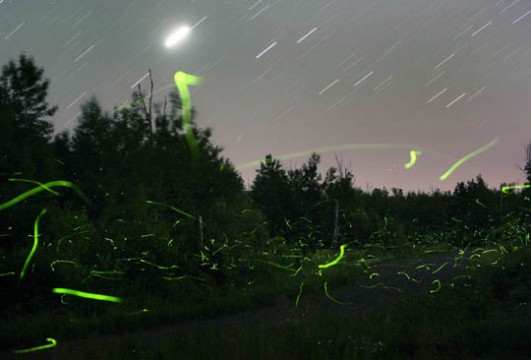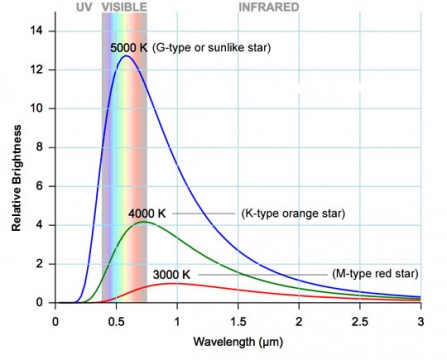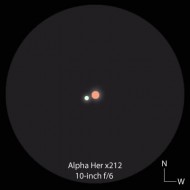July nights bring the green flicker of fireflies and a question — are there any green stars we can see in our telescopes? The answer may surprise you.

Bob King
Like many kids growing up in the Midwest, I collected fireflies on warm June and July nights. We'd cup the slow-flying beetles in our hands and transfer them to a jar with holes poked in the lids for air. All the while they tried to escape by crawling back up our hands and arms. Later, I'd set the jar by the bedside and fall asleep to their silent flashes.
I still love fireflies, though I don't catch them anymore. More often they catch me. By surprise. When out observing, I've mistaken them for meteors, Iridium satellites, and once, a supernova. That happened when one crawled into the bottom of my focuser and let off a blast of light while I was in middle of making a variable star estimate. Ka-boom!

ESO / Babak Tafreshi
The color of light emitted by the luciferin molecule responsible for the firefly's beacon can vary from green to yellow to red. In my neighborhood, most flash green, a color never exhibited by the stars overhead. It's true. We've all seen white, pale blue, yellow, orange, and red stars, but you'll search in vain for true green.
Here's the problem. Stars emit light across the visible spectrum with hotter stars radiating more light at shorter, bluer wavelengths and cooler stars at longer, redder wavelengths. Ruddy Antares in Scorpius has a surface temperature of 3600° Kelvin (6000° F) with a peak emission in the near-infrared end of the spectrum. The Sun is hotter at 5700° K (9800° F) with a blue-green peak. Yet Antares is certainly not "infrared colored" nor is the Sun blue-green.

Wikipedia, with additions by the author
Even though a star's peak emission may lie anywhere in the spectrum, it also pours out lots of light at other wavelengths. Blended together, this makes most stars, including the Sun, appear white or, at the very least, weakly color-saturated. Green stars are absent for the same reason. Any star hot enough to emit a significant amount of green light will also radiate blue, red, and all the rest, effectively masking the green. Flooded with every color of the spectrum, we see white. Kermit had it right all along: "It isn't easy being green."

Bob King
So are the twinkles of fireflies as close as we'll come to seeing green on a July night? Not if you take advantage of color contrast in double stars.
Double stars where the brighter primary star is vividly orange or red will cause its fainter companion to assume the complementary color. Red stars "push" their fainter companions towards green, while yellow stars make us see the secondary as blue. This is all the more interesting when you realize that most of these companions are far too dim to excite the eye's cone cells responsible for color vision. Seeing can be a very subjective thing.
Looking over older double star observations, you'll sometimes come across descriptions of "apple green" or "emerald green". There's even a single star, Libra's Zubeneschmali (Beta Librae), that some observers claim looks green, though to my eye, it appears white.
Just as we find artificial flavors better than no flavor at all, let's embrace the greens of double stars, even if they're nothing but ocular artifice. Below you'll find a few to peruse the next clear night. The "color pushing" just described is most easily seen with a brief look. Stare a while and the hues might just disappear. Be sure to check out the links, too. Some point you to beautiful digital sketches of double stars by Jeremy Perez. Good luck!

Bob King
* Izar (Epsilon Boötis) — Mags. 2.7, 5.1, separation 2.9″. Orange primary with a secondary some observers see as pale green.
* Rasalgethi (Alpha Herculis) — Mags. 3.1 and 5.4, sep. 4.9″. Lovely red-orange primary. This one works for me — I see green ... briefly!
* 95 Herculis — Mags. 4.8 and 5.2, sep. 6″. A real gem. Maybe because the magnitudes are so similar, this one presents an obvious color contrast for many, my eye included. A 19th-century amateur astronomer described them as "apple-green and cherry red."
* Graffias (Beta Scorpii) — Mags. 2.9 and 5.1, sep. 13.6”. One of the prettiest doubles of summer. I see two white stars, but some observers report the secondary as being slightly greenish.
* Antares (Alpha Scorpii) — Mags.1.0 and 5.4, sep. 2.5”. Probably the most famous example of color contrast. A tough challenge requiring excellent seeing, but if you can crack it, the companion looks distinctly green nestled next to its brilliant, orange-red primary.
* Zeta Lyrae — Mags. 4.3 and 5.9, sep. 44″. Ruddy primary and watery green secondary.
* Gamma Delphini — Mags. 4.4 and 5.0, sep. 9.1″. Awesome double! I see two yellowish stars but others see one yellow and one pale emerald.
Sky & Telescope has lots of great articles on double stars, as well as an observing guide for observing doubles with small scopes. Eagle Creek Observatory offers an extended list of color contrasted doubles if you'd like to explore further.
 5
5
Comments
Richard-Laughlin
July 1, 2015 at 9:40 pm
You reported star color as white instead of where others saw green. I recently purchased two 5 watt 626 industry standard LED Walmart lights for nightlight use, one in my bedroom where it is bright enough to read by without interfering with sleep, and one in the bathroom. The red bulb is orange when on, but illuminates red, with yellow glare on the bulb when looking at it while using the rest room in the middle of the night. I was using 660 nm red LEDs to show something at Veen Observatory which I saw as bright red, but the women with dark adaption saw a yellow green glow on each LED. I have blue eyes with an orange retina color, I passed my color examination when my father had the money in 2008, the one allowed failure, red orange, means that with an orange retina color Feb. 2015 and since childhood, the fovea was pure red with healthy rods to supply the perception of green. At Veen Observatory in Lowell, MI I had no trouble using averted vision to see the Whale Galaxy. When I was almost 4 years old at my sister's fifth birthday party with Mr. Patches the Clown filmed live outdoors for Channel 30 August 9, 1969; I was to be a big boy and help collect the serving trays after everyone ate, and put them into the correct colored piles, I collected the trays by screwed up the colored piles, but I did pass my colors as a kindergarten requirement with flying colors. I also have a color blind friend with a yellow retina, which is some green cones. With some green cones 660 nm at night, yellow green to women appears orange to the men. A star that appears white is correct to night vision, but when others see green, that means color blindness that still may pass the color test. 626 nm is industry standard for red LEDs, so during daytime conditions what it illuminates is red, and it takes time for the green cones to repair ultraviolet light damage.
You must be logged in to post a comment.
Anthony Barreiro
July 2, 2015 at 2:19 pm
I'm not sure about color-contrast in particular, but visual perception in general involves much more than just the retina. Visual inputs are processed in the mid-brain and routed to the cerebral cortex which puts everything together into a meaningful perception. Our perceptions are not just raw sensory data. We aggressively filter and actively interpret sense data to create a representation of the world. And it all happens in milliseconds, well before any conscious control is possible.
Oh, and thanks Bob for the list of color-contrast doubles. I've added them to my summer observing list. A few years ago, when I was just getting started with telescopic observation, figuring out why Albireo A was brighter and golden, while Albireo B was not so bright and blue, led to an aha moment when I first had a practical understanding of the fact that big stars burn through their hydrogen faster than smaller stars, and thus the bigger star in a binary will become a red giant sooner than the smaller star. I hope this wasn't just a color-contrast illusion!
You must be logged in to post a comment.
Bob KingPost Author
July 2, 2015 at 2:33 pm
Hi Anthony,
You're right. Albireo A is a K class giant that's fusing helium, while its companion is B dwarf still fusing hydrogen. By the way, some people report seeing the B star as green due to color contrast. For me, it's very pale blue, though perhaps that's also illusory!
You must be logged in to post a comment.
Jeff-Keese
July 3, 2015 at 4:54 pm
I remember reading an article years ago giving a reason for why some old star catalogs list many "clear green" stars, yet most viewers only see them as blue. Apparently with age the eye's cornea becomes progressively yellow tinted. A blue star seen through a yellow filter will look somewhat green. The article mentioned that whenever an older person has their cornea temporarily removed one of the first things that surprises them is how sheets of paper look so much whiter, and all colors are more vivid.
You must be logged in to post a comment.
Chris-Franks
July 5, 2015 at 12:36 pm
Absolutely true. I had the cornea of my right eye replaced with a clear carbonate in a cataract operation 8 years ago.
If I close my left eye, copy paper looks white, but using just the left eye it is yellow. I used the custom color, 256-bit palette in windows Paint to change the white that I see with one eye into the yellow white I see with the other, changing back and forth like you do when making star magnitude comparisons, I found that my left eye sees 17% more yellow. I always blamed cigarette smoke for the difference, but maybe it is just oxidation. I was near-sighted for most of my life, but with age the left eye is now 20/15, and I can see the plane of the moons of Jupiter unaided. I had him put a 2.0 diopter correction in the right eye so that I do not need glasses to read star charts.
Combined, I focus from 5 inches to infinity after 84 years.
You must be logged in to post a comment.
You must be logged in to post a comment.